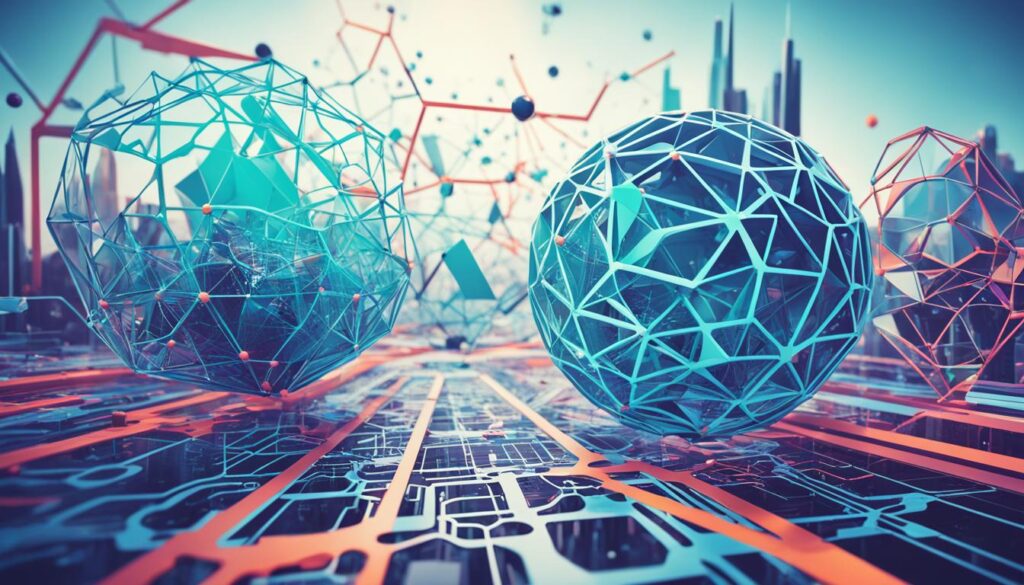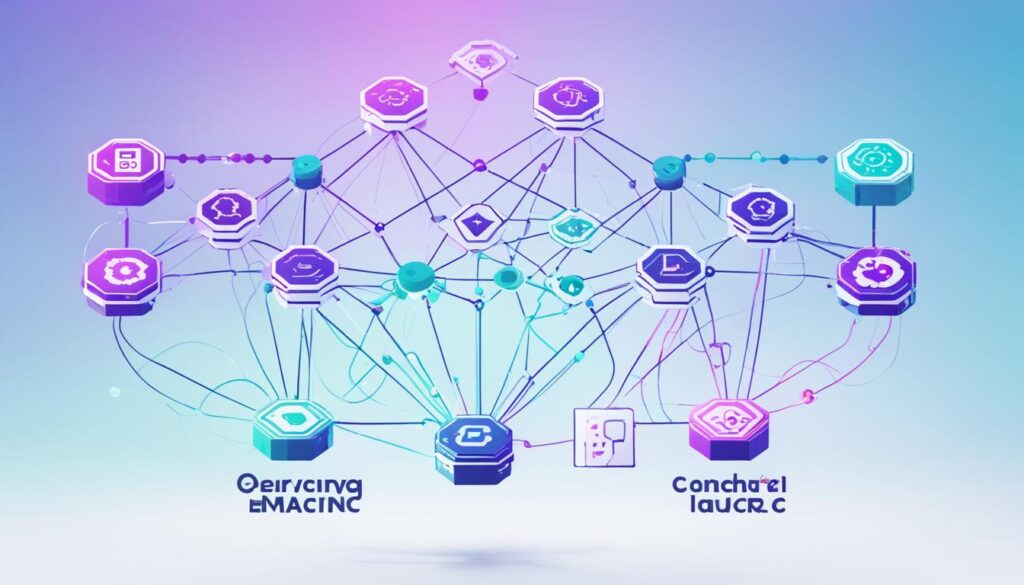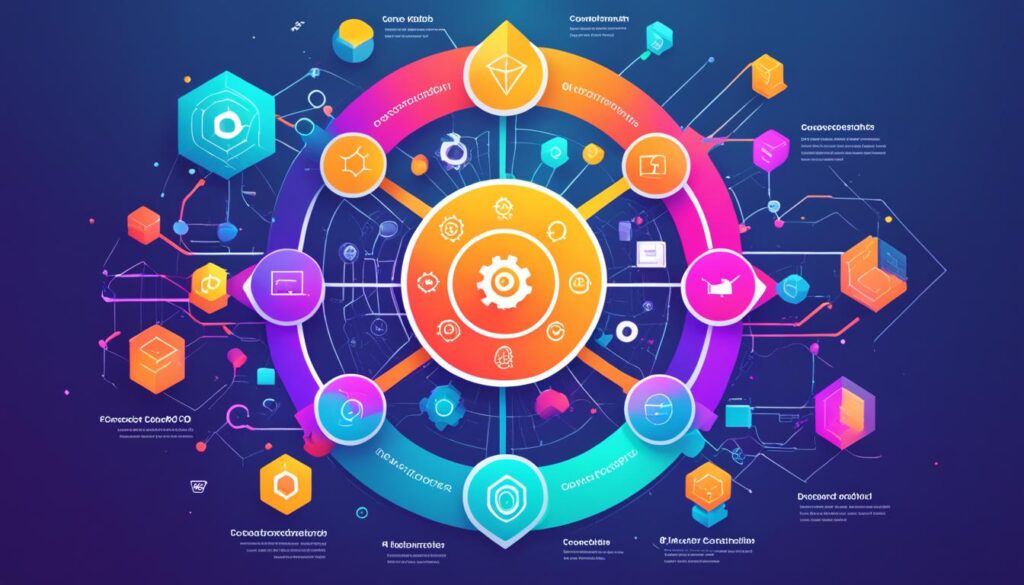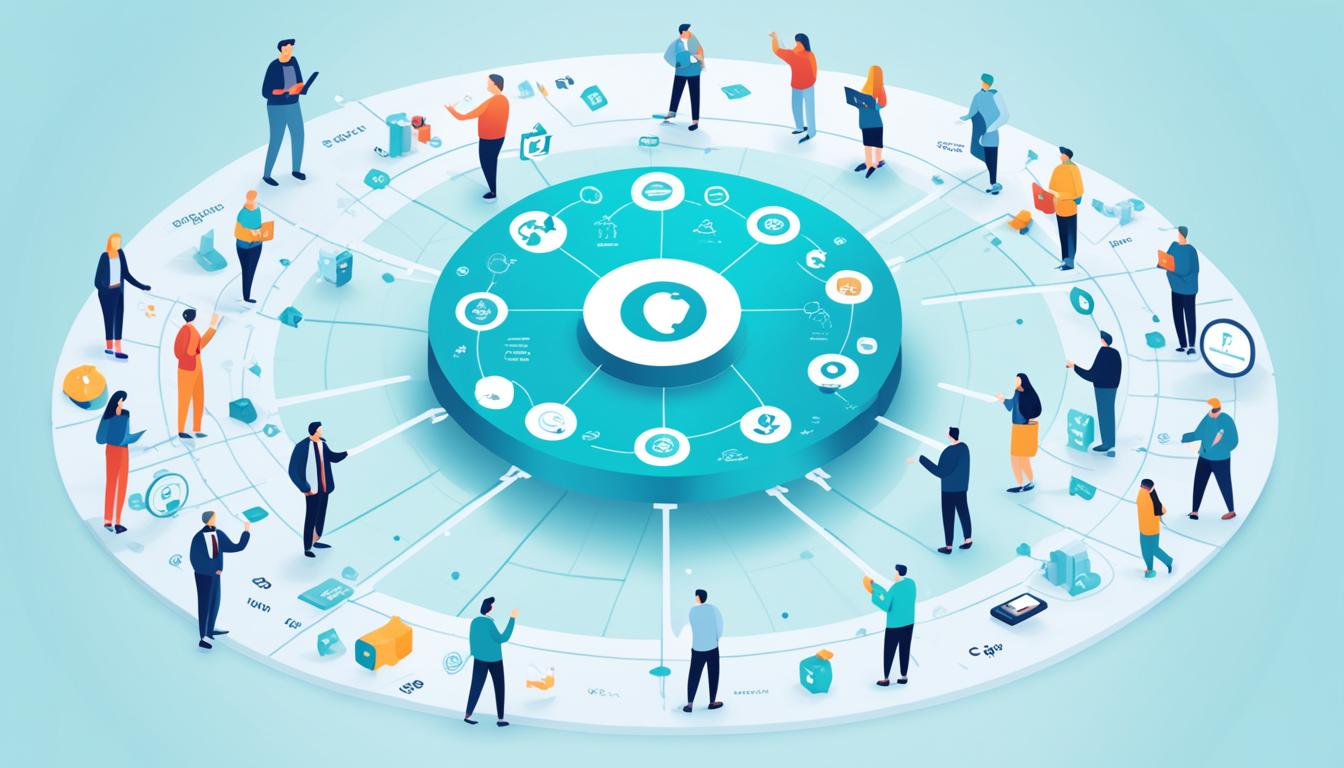The emergence of Web 3.0 is revolutionizing the sharing economy through decentralized platforms, transforming the way we share, collaborate, and interact in the digital world. This next generation of the World Wide Web combines blockchain technology, peer-to-peer networks, and smart contracts to create a more decentralized, secure, and efficient sharing economy.
Web 3.0 is redefining how industries operate globally by eliminating intermediaries and enhancing trust. Through the use of blockchain technology, transactions on decentralized platforms are transparent, tamper-resistant, and promote accountability. Peer-to-peer networks enable direct interactions between users, fostering collaboration and empowering individuals.
The distributed ledger technology of Web 3.0 ensures data integrity and security, providing a foundation for trust in collaborative consumption. Smart contracts, self-executing agreements written into code, automate trust and streamline processes, eliminating the need for intermediaries. This enables more efficient and cost-effective sharing of goods, services, and resources.
As Web 3.0 continues to evolve, its impact on the sharing economy will be significant. From ride-sharing to short-term accommodation rentals, decentralized platforms are disrupting traditional industries and empowering individuals to participate in the economy on their own terms.
Key Takeaways:
- Web 3.0 revolutionizes the sharing economy through decentralized platforms.
- Blockchain technology, peer-to-peer networks, and smart contracts are key elements of Web 3.0.
- Decentralized platforms eliminate intermediaries, enhancing trust and efficiency.
- Web 3.0 enables more transparent, secure, and personalized interactions.
- The sharing economy is undergoing a transformative shift with the advent of Web 3.0.
What is Web 3.0 (Web3)?
Web 3.0, also known as Web3, is the next evolution of the World Wide Web. It represents a fundamental shift in how we interact with the digital world, offering decentralized and peer-to-peer interactions, increased user control over data, and the integration of cutting-edge technologies like blockchain.
In Web 3.0, the focus is on creating a more intelligent and adaptive web experience. One of the key elements of Web3 is the Semantic Web, which aims to enhance the understanding of information by machines. This allows for more personalized and contextually relevant experiences for users.
Machine learning and AI integration play a pivotal role in Web 3.0 by enabling predictive capabilities and intelligent automation. These technologies analyze vast amounts of data to identify patterns, deliver personalized recommendations, and improve overall user experiences.
“Web 3.0 aims to empower users by placing them in control of their own data and online experiences. It prioritizes trust and security through the use of decentralized technologies, such as blockchain, while offering enhanced personalization and user-centric features.”
The integration of blockchain technology is a significant driver in the evolution of Web 3.0. By leveraging blockchain’s decentralized and secure nature, Web3 ensures transparency, immutability, and trust in online interactions. It introduces the concept of peer-to-peer networks and distributed ledgers, removing the need for intermediaries and fostering direct, secure transactions.
With Web 3.0, users have increased control over their data and digital identities, leading to a more personalized and tailored online experience. The aim is to empower individuals, allowing them to choose how their data is used, and granting them ownership over their digital footprint.
Key Features of Web 3.0:
- Decentralized and peer-to-peer interactions
- Increased user control over data
- Integration of blockchain technology
- Semantic Web for intelligent information processing
- Machine learning and AI integration
- Enhanced personalization and user experiences
- Focus on trust and security

As Web 3.0 continues to evolve, it has the potential to reshape the digital landscape, redefine online interactions, and usher in a new era of trust, security, and user-centricity.
Blockchain: The Backbone of User Web 3.0
Blockchain technology serves as the crucial foundation for User Web 3.0, offering a decentralized and tamper-resistant infrastructure that ensures the integrity and security of data. Its transformative impact on the digital landscape cannot be overstated.
At its core, blockchain provides a trustless environment by leveraging its immutable nature. This decentralized system enables data management in a secure and transparent manner, eliminating the need for intermediaries. By employing consensus algorithms and cryptographic hashing, blockchain ensures data integrity and safeguards against tampering, making it an ideal solution for the user-centric frontier of Web 3.0.
A key innovation within blockchain technology is the concept of smart contracts. These self-executing agreements, written into code and stored on the blockchain, automate trust and streamline processes in Web 3.0. By eliminating the need for third-party intermediaries, smart contracts enhance efficiency, reduce costs, and ensure transparency in various applications. They play a pivotal role in automating trust within the decentralized ecosystem, facilitating secure and efficient interactions.
“Blockchain, as a foundational technology, has the potential to revolutionize industries by providing a decentralized infrastructure that fosters trust and transforms traditional business models. Its integration within User Web 3.0 represents a significant step towards a more secure, transparent, and user-centric digital landscape.”
Decentralized applications, or dApps, are a hallmark of User Web 3.0. These applications prioritize user control, data ownership, and enhanced privacy, marking a paradigm shift in software development. Powered by blockchain technology, dApps allow users to interact directly with the network, enabling peer-to-peer transactions without intermediaries. Through dApps, users gain greater control over their digital experiences, driving innovation, and promoting a more inclusive and decentralized internet.
Web 3.0, with blockchain at its core, paves the way for a new era of digital innovation, where trust, security, and user-centricity take center stage. As technologies continue to evolve, blockchain will remain a key pillar in shaping the future of User Web 3.0.

| Benefits of Blockchain in User Web 3.0 |
|---|
| Decentralized and tamper-resistant infrastructure |
| Ensures data integrity and security |
| Automates trust through smart contracts |
| Prioritizes user control, data ownership, and privacy |
Modern Software Development in the User Web 3.0 Era
Modern software development in the User Web 3.0 era is driven by the principles of decentralized identity and privacy, tokenization and incentive mechanisms, interoperability and open standards, and community-led development. These key factors shape the development practices and strategies that are revolutionizing the digital landscape.
Decentralized Identity and Privacy
In the User Web 3.0 era, decentralized identity and privacy solutions play a crucial role in empowering users with greater control over their personal information. By leveraging blockchain technology, users can securely manage their identities, ensuring privacy and reducing reliance on centralized authorities. This shift towards decentralized identity systems fosters trust and enhances user privacy in an increasingly interconnected digital world.

Tokenization and Incentive Mechanisms
In User Web 3.0, tokenization and incentive mechanisms drive user participation and collaboration within decentralized networks. By tokenizing assets and leveraging cryptocurrencies, developers create ecosystems that incentivize users to contribute their skills, data, and resources. This creates a more inclusive and collaborative environment, where users are rewarded for their active engagement and contribution to the network.
Interoperability and Open Standards
Interoperability and open standards are critical considerations in Web 3.0 software development. With the proliferation of decentralized applications (dApps) across various networks and blockchains, it becomes essential to establish seamless communication and collaboration between different applications. Open standards ensure compatibility, enabling interoperability and fostering innovation within the decentralized ecosystem. This allows users to transcend platform boundaries and experience a seamless and integrated digital experience.
Community-Led Development
Community-led development is at the heart of Web 3.0’s ethos. The open-source nature of Web 3.0 encourages collaborative efforts and transparent development practices. Developers and users alike actively contribute to the improvement and evolution of decentralized technologies, fostering a sense of ownership and inclusivity. This community-centered approach to development ensures that the needs and aspirations of the user base are prioritized, leading to innovative solutions and a more inclusive digital future.
As software development in the User Web 3.0 era continues to evolve, the focus on decentralized identity and privacy, tokenization and incentive mechanisms, interoperability and open standards, and community-led development remains paramount. These core principles not only revolutionize the way we build and interact with digital applications but also pave the way for a more transparent, user-centric, and interconnected digital landscape.
Challenges and Future Prospects
While Web 3.0 brings unprecedented opportunities, it also presents challenges that must be addressed for its successful implementation and widespread adoption. These challenges include:
- Scalability: Web 3.0 operates on decentralized networks, which can face scalability issues when it comes to processing large volumes of data and transactions.
- Regulatory Concerns: The decentralized nature of Web 3.0 raises regulatory questions in areas such as data privacy, intellectual property rights, and financial regulations.
- User Adoption: The transition to Web 3.0 requires user adoption and acceptance. Educating users about the benefits and functionalities of Web 3.0 is crucial for its widespread adoption.
Addressing these challenges will require collaborative efforts from various stakeholders, including developers, regulators, and the broader tech community.
“The future of Web 3.0 hinges on the ability of different stakeholders to come together and collectively address the challenges it presents. Only through collaboration can we unlock the true potential of a decentralized and interconnected internet.”
Despite these challenges, the future prospects of Web 3.0 are promising. By placing users at the center of the digital experience and prioritizing trust, privacy, and personalization, Web 3.0 has the potential to transform industries, enhance user experiences, and redefine the internet as we know it.
Redefining the Internet
Web 3.0 aims to redefine the internet by enabling a more decentralized and interconnected digital landscape. It empowers users by giving them greater control over their data, enabling peer-to-peer interactions, and leveraging technologies like blockchain to enhance trust and security.
Through Web 3.0, users can expect:
- Enhanced privacy and data ownership
- Improved user experiences through personalization
- A shift towards user-centric applications and services
By embracing these principles and overcoming the challenges along the way, Web 3.0 has the power to reshape the internet, creating a more transparent, inclusive, and collaborative digital ecosystem.
The Evolution and Future of Web 3.0
In the rapidly evolving digital landscape, Web 3.0 stands at the forefront of technological advancements. Built upon the foundation of decentralized technologies such as blockchain, cryptocurrency, and AI, Web 3.0 is revolutionizing the way we interact and connect online.
One concept closely intertwined with Web 3.0 is the metaverse. The metaverse is a proposed 3D virtual world that relies on decentralized technologies to enable its development. It represents a new frontier where users can immerse themselves in virtual experiences, interact with one another, and create self-governed digital communities.
As Web 3.0 continues to evolve, we can expect the integration of emerging technologies to further enhance its capabilities. Technological advancements will drive the creation of more immersive and interactive virtual experiences within the metaverse. This includes the incorporation of augmented reality (AR), virtual reality (VR), and mixed reality (MR) to create a seamless blend of physical and digital environments.
Decentralized governance is also a key area of development in the future of Web 3.0. As self-governed digital communities emerge, decentralized decision-making processes and consensus mechanisms will shape the rules and regulations within these communities. This shift towards self-governance empowers individuals and fosters independence and collaboration.
Furthermore, the evolution of Web 3.0 will emphasize the creation of self-governed digital communities that prioritize trust, transparency, and inclusivity. These communities will enable individuals to connect and collaborate in a decentralized manner, driving innovation and unlocking new opportunities. Educational initiatives, collaborative projects, and shared resources will thrive within these digitally connected ecosystems.
The future of Web 3.0 holds immense potential. It will redefine how we interact with the digital world, transcending the boundaries of traditional web experiences. By embracing decentralized technologies, Web 3.0 will enable a more interconnected, immersive, and inclusive digital future.

| Decentralized Technologies | Metaverse | Technological Advancements | Self-Governed Digital Communities |
|---|---|---|---|
| Blockchain | AR, VR, MR | Decentralized Governance | Collaboration and Innovation |
| Cryptocurrency | Immersive Experiences | Self-Governance | Trust and Transparency |
| AI | Interconnected Ecosystems | Consensus Mechanisms | Digital Independence |
Conclusion
Web 3.0 is revolutionizing the sharing economy by leveraging decentralized platforms, reshaping industries, enhancing user experiences, and fostering trust. Through the integration of blockchain technology, peer-to-peer networks, and smart contracts, Web 3.0 is redefining the future of the internet and placing users at the forefront of the digital experience.
As Web 3.0 continues to evolve, it holds immense potential to transform how we share, collaborate, and interact in the digital world. By eliminating intermediaries and enhancing transparency, Web 3.0 empowers individuals and communities to engage in collaborative consumption on a global scale.
Decentralized platforms offered by Web 3.0 provide a secure and efficient environment for sharing resources, while also ensuring data privacy and ownership. This shift towards a more user-centric and trusted sharing economy has profound implications for various industries, including finance, healthcare, and transportation. As we embrace the future of the internet powered by Web 3.0, we are likely to witness a more decentralized and interconnected digital landscape.
FAQ
How is Web 3.0 revolutionizing the sharing economy with decentralized platforms?
Web 3.0 is revolutionizing the sharing economy by combining blockchain technology, peer-to-peer networks, and smart contracts to create a more decentralized, secure, and efficient sharing economy. It eliminates intermediaries, enhances trust, and changes the dynamics of collaborative consumption.
What is Web 3.0 (Web3)?
Web 3.0, also known as Web3, is the next evolution of the World Wide Web. It is characterized by decentralized and peer-to-peer interactions, increased user control over data, and the integration of technologies like blockchain. Web 3.0 aims to create a more intelligent and adaptive web through the implementation of the Semantic Web, machine learning, and AI.
How does blockchain technology contribute to User Web 3.0?
Blockchain technology provides a decentralized and tamper-resistant infrastructure for data management in User Web 3.0. Its immutable nature ensures data integrity and security, fostering trust in a trustless environment. Additionally, smart contracts automate trust, eliminating the need for intermediaries and streamlining processes. Decentralized applications (dApps) prioritize user control, data ownership, and enhanced privacy.
What are the key considerations in modern software development for User Web 3.0?
Modern software development in the User Web 3.0 era focuses on decentralized identity and privacy solutions, allowing users greater control over their personal information. Tokenization and incentive mechanisms incentivize user participation and collaboration within the decentralized network. Interoperability and open standards ensure seamless communication and collaboration between different applications. Community-led development encourages open-source initiatives and collaboration, ensuring transparency and community involvement.
What challenges does Web 3.0 face, and what are its future prospects?
Web 3.0 faces challenges in terms of scalability, regulatory concerns, and user adoption. Overcoming these challenges requires collaborative efforts from developers, regulators, and the broader tech community. However, the potential of Web 3.0 to redefine the internet and shape a more decentralized and interconnected future cannot be underestimated.
How does the evolution of Web 3.0 intersect with decentralized technologies and the concept of the metaverse?
The evolution of Web 3.0 builds upon decentralized technologies like blockchain, cryptocurrency, and AI. The concept of the metaverse, a proposed 3D virtual world, is closely intertwined with Web 3.0, as both rely on decentralized technologies for their development. The future of Web 3.0 will likely involve the integration of emerging technologies, advancements in decentralized governance, and the creation of self-governed digital communities.
What is the impact of Web 3.0 on the sharing economy and decentralized platforms?
Web 3.0 is revolutionizing the sharing economy through decentralized platforms, transforming industries, enhancing user experiences, and fostering trust. It places users at the center of the digital experience and redefines how we share, collaborate, and interact in the digital world, shaping a more decentralized and interconnected future.








